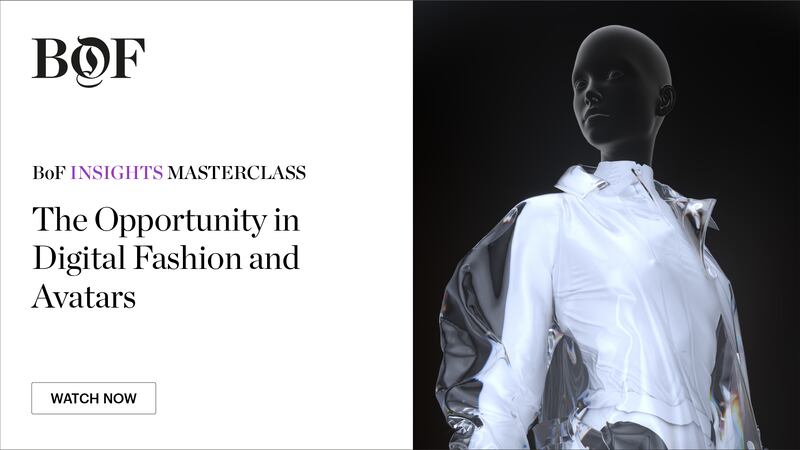
The Business of Fashion
Agenda-setting intelligence, analysis and advice for the global fashion community.

Agenda-setting intelligence, analysis and advice for the global fashion community.

The author has shared a YouTube video.
You will need to accept and consent to the use of cookies and similar technologies by our third-party partners (including: YouTube, Instagram or Twitter), in order to view embedded content in this article and others you may visit in future.
Created by BoF’s journalists and editors, in conjunction with our wider network of leading fashion creatives, thought-leaders, and innovators, Masterclasses are in-depth webinars with supporting resources, designed to deliver key learning outcomes on critical industry topics.
One of fashion’s hottest trends this year is clothes that can’t be worn at all. Brands have gone big on virtual dressing, dabbling in digital fashion and scoring blow-out sales on NFT drops.
But is the buzz the mark of a bubble or a real long-term opportunity? For this Masterclass, BoF’s director of research and analysis, Diana Lee, and head of strategy, Rahul Malik, spoke with Rachel Waller, global vice president of channel innovation at Burberry, and Helene Phillips, global head of digital and client experience at Jimmy Choo about how the fashion industry can prepare for the next digital frontier.
The conversation drew on analysis from BoF Insights’ digital fashion report, focusing on how brands can look beyond the current hype to future opportunities. Digital assets will be integral to future-proofing businesses as consumers spend a growing amount of time online, the report found.
ADVERTISEMENT
“Fashion is about building universes and making you dream. In many ways, what we have here is an opportunity to bring some of those dreams to life,” said Burberry’s Waller. The digital realm “allows us to tell stories in a much richer way than maybe some of the previous canvases have before.”
Burberry has partnered with the video game Blankos Block Party to launch one-of-a-kind branded avatars. The characters are non-fungible tokens, or NFTs, unique digital assets whose authenticity and ownership are verified by a digital ledger known as a blockchain. It’s part of a strategy to tap into Gen-Z audiences and capitalise on the growing proportion of time consumers are spending online.
To be sure, such projects are still largely experimental and there are plenty of questions around how emerging technologies will serve the fashion industry in the long term. Gaming is one way in for now, but there are other potentially bigger opportunities.
For instance, NFTs have burgeoning applications, including as a creative new type of loyalty scheme to reward communities. The panellists pointed to the fervour of the Bored Apes Yacht Club community — and the associated social capital of being a member — as an example. With the number of possibilities and the options for engagement, it is incumbent on fashion brands and retailers to choose wisely in picking their next steps.
Brands shouldn’t try to go it alone, but collaborate with partners who speak to the audience they are targeting. Jimmy Choo auctioned two types of NFTs that were designed by New York artist Eric Haze and curated by Japanese style icon Poggy.
“The short-term play is having strategic partnerships with the right players,” said Phillips, noting that Jimmy Choo tapped strategic partners to “ensure they had the right contacts on platforms, including with crypto communities.”
 Opens in new window
Opens in new windowBoF Insights’ guide to digital assets in fashion, which examines the rise of the metaverse and underlying technological, social and consumer shifts, plus includes a playbook for how to seize the opportunity.
Physical and digital worlds merge in the Metaverse. Can the luxury world dematerialise into the virtual space fast enough to attract eager customers — and their avatars?
The coming of a collective, persistent, virtual reality will fundamentally transform how we live and shop, writes retail guru Doug Stephens.
Zero10 offers digital solutions through AR mirrors, leveraged in-store and in window displays, to brands like Tommy Hilfiger and Coach. Co-founder and CEO George Yashin discusses the latest advancements in AR and how fashion companies can leverage the technology to boost consumer experiences via retail touchpoints and brand experiences.
Four years ago, when the Trump administration threatened to ban TikTok in the US, its Chinese parent company ByteDance Ltd. worked out a preliminary deal to sell the short video app’s business. Not this time.
Brands are using them for design tasks, in their marketing, on their e-commerce sites and in augmented-reality experiences such as virtual try-on, with more applications still emerging.
Brands including LVMH’s Fred, TAG Heuer and Prada, whose lab-grown diamond supplier Snow speaks for the first time, have all unveiled products with man-made stones as they look to technology for new creative possibilities.